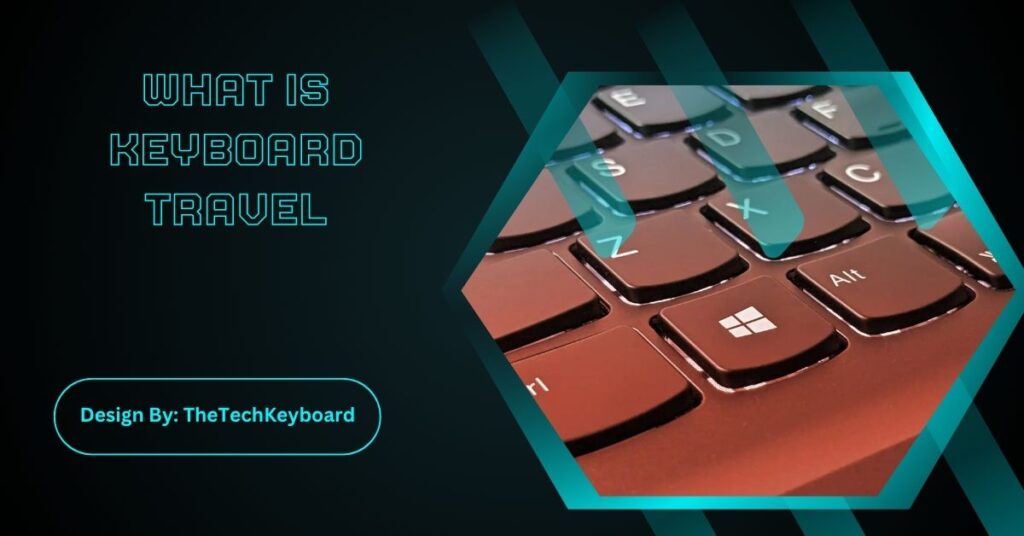Keyboard travel measures how far a key moves when pressed, affecting typing feel, comfort, and speed. Short travel suits gaming and portability, while longer travel benefits writers seeking tactile feedback and reduced fatigue.
Keyboard travel, also called key travel distance, refers to how far a key moves down when you press it until it hits the bottom and registers the input. It is measured in millimeters (mm) and affects the typing comfort, speed, and overall feel of a keyboard. Many people overlook this feature when buying a keyboard, but it can significantly impact gaming performance, productivity, and typing ergonomics.
Understanding Keyboard Travel in Simple Terms
When you press a key, it doesn’t instantly register. It travels downward through a certain distance before activating the switch underneath. This distance is known as key travel. Short travel feels quick and responsive, while long travel gives a cushioned and tactile experience.
Most modern laptop keyboards have shorter travel (around 1–1.5 mm), while mechanical keyboards can have longer travel (2–4 mm). Finding the right balance depends on personal preference and typing needs.
Why Does Keyboard Travel Matter?

Key travel directly influences typing experience, fatigue levels, and accuracy. Here’s why it’s important:
- Typing Comfort – Longer travel reduces finger strain for extended typing.
- Feedback – Better tactile response for writers and gamers.
- Speed – Shorter travel can improve fast-paced gaming or rapid data entry.
- Ergonomics – Balanced travel prevents stress on joints and muscles.
Different Types of Keyboard Travel
1. Short Travel Keyboards
- Found in ultrabooks and thin laptops.
- Travel distance: 1.0 mm to 1.5 mm.
- Pros: Fast response, slim design, portable.
- Cons: Less tactile feedback, can feel “shallow.”
2. Medium Travel Keyboards
- Common in membrane and scissor-switch keyboards.
- Travel distance: 1.8 mm to 2.5 mm.
- Pros: Balanced comfort and feedback.
- Cons: Not as fast as short travel or as cushioned as long travel.
3. Long Travel Keyboards
- Typical in mechanical keyboards.
- Travel distance: 3.5 mm to 4 mm.
- Pros: Excellent tactile feel, great for typing accuracy.
- Cons: Can feel “slower” for gaming or casual use.
Mechanical vs. Membrane Key Travel
Mechanical Keyboards
- Have individual switches for each key.
- Travel distance: 2–4 mm.
- Excellent tactile feedback, durability, and customization.
Membrane Keyboards
- Use rubber dome or scissor mechanisms.
- Travel distance: 1–2 mm.
- Affordable, quieter, and slim but less tactile.
How to Measure Keyboard Travel?
Key travel is usually listed in the keyboard specifications. If not:
- Use a ruler or caliper to measure how far the key moves downward.
- Check the manufacturer’s website for switch travel distance.
- Compare with common switch types like Cherry MX, Razer, or Romer-G.
Ideal Keyboard Travel for Different Uses
For Typing/Writing
Writers often prefer longer key travel (2.5–4 mm) for comfort and reduced fatigue during long sessions. Mechanical switches like Cherry MX Brown or Blue are popular among writers.
For Gaming
Gamers may prefer shorter travel (1.2–2 mm) for faster key actuation. Low-profile mechanical or optical switches are commonly chosen for competitive gaming.
For Office Work
Balanced travel (around 2 mm) works best. It provides comfort for typing emails and documents without excessive noise.
Advantages of Short Key Travel
- Faster actuation for gaming.
- Slim keyboard designs.
- Less finger movement = higher speed for some users.
Advantages of Long Key Travel
- Better feedback and typing accuracy.
- More comfortable for extended sessions.
- Preferred by professionals and mechanical keyboard enthusiasts.
Choosing the Right Keyboard Travel

When buying a keyboard:
- Test in person – Feel different key travel distances.
- Know your purpose – Gaming vs. writing vs. general use.
- Consider ergonomics – Longer travel reduces finger stress.
- Look at switch types – Each switch brand has unique travel specs.
Popular Key Travel Distances in Today’s Market
- Apple MacBook Keyboards: 1–1.2 mm (short travel).
- Gaming Mechanical Keyboards: 2–4 mm (medium to long travel).
- Business Laptops (ThinkPad): 1.5–2 mm (balanced travel).
Future Trends in Keyboard Travel
Manufacturers are experimenting with low-profile mechanical switches and haptic feedback keyboards to combine fast response with comfortable feedback. Future designs aim for quiet typing, adjustable travel distances, and customizable actuation points for both gamers and professionals.
FAQs:
1. What is a good key travel distance for gaming?
A travel distance of 1.2 to 2 mm is ideal for gaming, offering quick actuation and responsive keystrokes. Many esports players prefer low-profile mechanical switches or optical switches for faster reaction times and accuracy.
2. Does longer key travel improve typing comfort?
Yes, longer travel (2.5–4 mm) provides more cushioning and reduces finger fatigue during extended typing sessions. Writers and programmers often prefer this, as it offers better tactile feedback and a satisfying keypress feel.
3. Can I adjust keyboard travel on any keyboard?
Most keyboards have fixed travel, but some advanced mechanical and gaming keyboards offer adjustable actuation points. You can also modify the feel using O-rings or switch types, but travel itself is usually set by design.
4. Are laptop keyboards worse because of short key travel?
Not necessarily. Short travel allows thinner designs and faster input. However, some users find them less comfortable for prolonged typing compared to desktop mechanical keyboards with longer travel and better tactile feedback.
5. How do I know if key travel affects my typing speed?
Try typing tests on different keyboards. If you type faster with shorter travel but feel more errors, longer travel may suit you better. Comfort and accuracy matter more than pure speed for daily use.
Conclusion:
Keyboard travel is a small but crucial detail influencing comfort, speed, and accuracy. Whether you’re gaming, coding, or writing, understanding how key travel works helps you select the right keyboard for your needs. Short travel offers speed and portability, while long travel ensures comfort and feedback. Always test different keyboards before buying and choose one that matches your workflow and preferences for the best typing experience.


